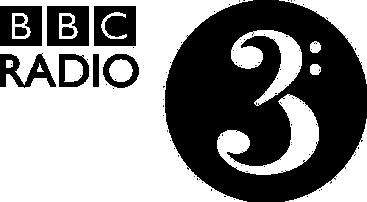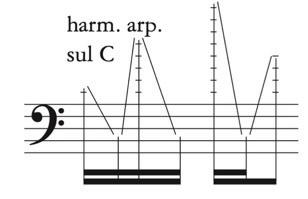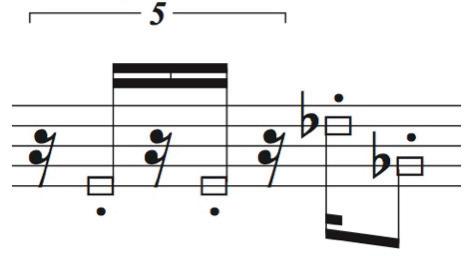GEORGE LEWIS
for Symphonic Orchestra and Interactive Electronics
Full Score
Commissioned by BBC Radio 3 and first performed on 26 August 2021 by the BBC Scottish Symphony Orchestra, conducted by Ilan Volkov, at the Royal Albert Hall, London, as part of BBC Proms 2021

ALLE RECHTE VORBEHALTEN ALL RIGHTS RESERVED EDITION PETERS L E I P ZI G L ONDO N NE W YOR K
Minds in Flux POD PETERS on demand
Instrumentation
Flutes 1 and 2 in C
Oboe 1 and 2
Clarinets 1 and 2 in B-flat (clarinet 2 doubles Bass Clarinet in B-Flat)
Bassoon 1 and 2
Horn in F 1 and 2
Trumpet in C 1 and 2 (mutes: straight, harmon with stem, plunger)
Trombone (mutes: straight, harmon with stem, plunger)
Tuba
Timpani (sticks, mallets, brushes, Superball beaters)
Harp (with plastic card)
Piano
Percussion I (sticks, mallets, brushes, Superball beaters)
Snare Drum High tom-tom Low tom-tom
High and Low Bongos Maracas Glockenspiel
Medium Cymbal Medium Tam-tam Medium Triangle
3 Bossed Gongs (C#4, F#4, G#5, B5, in treble staff)
Percussion II (sticks, mallets, brushes, Superball beaters)

High tom-tom Low tom-tom Bass drum
Large Cymbal Large Tam-tam Large Triangle
Castanets Xylophone Flexatone
3 Bossed Gongs (D#3, E3, F3, A3, in bass staff)
Violin I
Violin II
Viola
Cello
Contrabass
Symbols
s.t.: sul tasto (arco)
s.p.: sul ponticello (arco), normal pressure
c.l.b.: col legno battuto
m.s.t., a.s.t.: molto sul tasto (arco)
m.s.p., a.s.p.: molto sul ponticello (arco)
flz.: flutter-tongue
m.p.: moderate bow pressure (some pitch) h.p.: heavy bow pressure (some pitch)
bisb.: bisbigliando (in winds, timbre trill)
+ = closed plunger or harmon mute
B = quarter-tone flat
μ = quarter-tone sharp
o = open plunger or harmon mute
Bb = three-quarter-tone flat
˜ = three-quarter-tone sharp
m.v., m.m.v.: molto (molto) vibrato (normal speed, widest pitch range possible)
harm. arp.: Harmonic arpeggio. Rhythm and movement trajectories of the left hand are suggested by the indeterminate notation.

shake (brass):
square or open noteheads: indicates air sound, growls, or other production of indefinite pitch , multi, multiph: stable multiphonic sound on given note highest note possible

Boxnotation: V = create Versions of immediately preceding passage bow pressure specification (relative): high


low
Vibrato: Should match the duration of the first note to which they are attached. Speed is similar to normal vibrato, but pitch range is much wider, similar to Korean sigimsae in sanjo performances.




wide
narrow gradually widening and narrowing pitch range fading growing “jeonseong” (quick, grace note-like, accented rise and fall in pitch)
General performance notes
voice multi, with voice: sing and play together
smear: play with rough texture
voice grunt (winds): Use rough-textured voice and play at the same time.
flap tongue, slap tongue (winds): Both produce percussive sounds with some pitch content, which may be indeterminate in performance with respect to the written pitches. In brass, the technique is analogous to the flutist’s tongue ram.
air sound (woodwinds): Sharp, hissy breath textures are intended.

air sound, mouthpiece reversed (brass): Remove the mouthpiece and apply explosive tonguing to the shank end, with the cup of the mouthpiece near to, but not directly coupled to, the leadpipe of the instrument. Produces sharply percussive, wide-band noise attacks.
ceramic cup or guitar slide on strings (piano): A method of producing piano glissandi.
glissandi:
Short, leading toward an attack: Treated like sliding grace notes. Short, trailing a note: Analogous to a short verbal shout.
Long, trailing a note: Should not exceed the total duration of the note. Follow approximate pitch curve. Between notes: Follow approximate pitch curve.

irregular speed: Used with trills and vibrato to produce non-uniform textures.

The score is transposed, in the customary way:
Clarinet sounds a major 2nd lower than written
B-Flat Bass Clarinet sounds a major 9th lower than written.
Horn sounds a perfect 5th lower than written
Glockenspiel sounds two octaves higher than written
Contrabass sounds an octave lower than written

M
The orchestration assumes German string seating, with first violins and cellos on the conductor’s left, and second violins and violas on the conductor’s right.
Specifications as to instruments, bowings, mutes, articulations, etc., are maintained until superseded by a subsequent specification, or by the “ord.” instruction. Accidentals carry through the measure. Trills are always half-step, and are executed with irregular speed, as with tremolos. Specified vibrato is always irregular, unstable, and non-synchronized.

Electronics: This work utilizes a Max patch designed and constructed by Damon Holzborn. The patch runs on a Apple Mac computer (there is no Windows version) equipped with an eight-channel in/out USB or Firewire audio interface. The electronics digitally spatialize and timbrally transform the sounds of key instruments in the orchestra. The patch and instructions for its use are available upon request.
Each rehearsal number, i.e.,, is a cue that corresponds to an electronics preset composed for that section of the piece. In performance, the orchestra proceeds sequentially through these cues, and a person following the score steps through the corresponding presets on the patch, using a mouse, trackpad, or USB foot pedal.
These instruments should be VERY closely miked for best results, with clip-on mics or pickups. DO NOT USE conventional mics on stands unless there is no other possibility. The output of the microphones is sent to the audio interface, and from there to a high-quality multi-channel sound system. The audio connections are presented as part of a separate document.
Duration: 30 minutes
This work was composed at the Wissenschaftskolleg zu Berlin (Institute for Advanced Study) in June 2021.

6 6 6 6 6 6 6 6 6 6 6 6 6 6 6 6 6 6 6 6 6 6 6 6 6 6 6 6 6 6 6 6 6 6 6 6 6 6 6 6 6 6 6 6 6 6 6 6 6 6 6 6 6 6 6 6 6 6 6 6 6 6 6 6 6 6 6 6 6 6 6 6 6 6 6 6 6 6 6 6 Edition Peters 68741 © 2021 by C. F. Peters Corporation, New York 5/2023
3 33 5 3 3 6 6 6 6 6 6 6 6 6 6 6 6 6 6 6 6 6 6 6 6 3 3 3 6 6 6 6 6 6 6 6 6 6 6 6 6 6 6 6 6 6 6 6 3 3 3 6 6 6 6 6 6 6 6 6 6 6 6 6 6 6 6 6 6 6 6 3 3 3 6 6 6 6 6 6 6 6 6 6 6 6 6 6 6 6 6 6 6 6
3 3 3 3 6 6 6 6 6 6 6 6 6 6 6 6 6 6 6 6 6 6 6 6 6 6 6 6 6 6 6 6 6 6 6 6 6 6 6 6 6 6 6 6 6 6 6 6 6 6 6 6 6 6 6 6 6 6 6 6 6 6 6 6 6 6 6 6 6 6 6 6 6 6 6 6 6 6 6 6 6 6 6 6
33 3 3 5 5 3 6 6 6 6 6 6 6 6 6 6 6 6 6 6 6 6 6 6 6 6 3 33 5 3 3 6 6 6 6 6 6 6 6 6 6 6 6 6 6 6 6 6 6 6 6 3 3 3 6 6 6 6 6 6 6 6 6 6 6 6 6 6 6 6 6 6 6 6 6 6 6 6 6 6 6 6 6 6 6 6 6 6 6 6 6 6 6 6
6 6 6 6 6 6 6 6 6 6 6 6 6 6 6 6 6 6 6 6

3 5 3 5 5 5 5 V V V V V 5 5 3 5 3 5 5 5 5 V V V V V
+o+o +o+o | +o+o +o+o + + o + + + + + 5 5 5 3 3 V 5 3 V V 3 V V
o o + 3 3 3 5 3 5 5 V V V V V V V V V V
3 5 3 5 5 3 3 3 3 V V V V V V V V 5 3 3 V V

5
3 5 5 3 5 3
3 5 5 3 7 55 5 3

5 3 3
+o+o | +o+o


3 5 3 3 5 3 3 5 3 about40seconds about40seconds about40seconds about40seconds about40seconds about40seconds about40seconds V V V V V 5 7 3 3 5 7 7 5 3 3 5
3 3 5 3 3 5 7 3 5 5 3 3 5 5 7 3 3 5
7 5 3 3 5 7 33 5 3 3 5 5 7 3 3 5
5 5 3 3 5 7 7 5 3 3 5 3 3 7
7 3 3 5 3 3 7 7 3 3 5

3 3 7 7 3 3 5 3 3
3 3 3 3 3 3
3 3 3
3 3 3 3 3 3 3 3 3 3 3
3 3 3 3 3 3 3 3 3

5 5 5 5 5 5 5 5 5 5 5 5 5 5 5
5 5 5 5 5 5 5 55 5 5 5 5 55 5 5 5 5
5 5 5 5 5 5 55 55 5 5 5 5 5 55 55
5 5 5 5 5 5 5 5 5 5 5 5 5 5 5 5 5 5 55 5
5 5 5 5 5 5 5 5 55 5 5

5 5 5 5 5 5 3 5 5 5
55 5 5 5 5
5 5 7 5 5
5 5 5 5 5 5 5

5 5 5 – – – –– –
5 5 5 3 5 5 5 5 5 5 –– – – – – – –
5 5 – 3 5 5 5 5 5 – – ––

3 5 5 5
V V V V V

3 3 3 3 3 3 5 5 5 6656 6 3 3 3 3 3 3 5 5 5 65 5 6 3 3 3 3 3 3 3 3 5 5 5 3 3 5 5 6 5 7
+ + + 3 3 5 5 3 3 3 6
+ + + + + + 3 6 6 5 6 33 566 6 7 5 66 6 3
+ + + + + + + + + + + 5 55 6 3 566 5 3 66 66 6 7 3

3 5 3 5 3 5 5 3 5 3 3 5 3 5 5 5 3 3
5 3 5 3 5 5 3 5 3 3 5 3 5 3 53 5 3

5 5 5 5 5 5 5 5 5 5 5 5 5 5 5 5 5 5 5 5
5 5 5 5 5 5 5 5 5 5 5 5 5 5 5 5 5 5 5 5

5 5 5 5 5 5 5 3 3 5 5 5 5 5 5 3 3 5 5 5 5 5 5 3 3 5 5 5 5
+o+o +o+o +o+o +o+o +o+o | +o+o 5 3 5 5 3 3 3 3 3 3 3 3
+o+o +o+o | +o+o |
+o+o | +o+o | +o+o | 3 3 3

3 3 3 3
3 3 3 3
3 3 3 3 3

3 3 3 3 3 3 5 3 3 5 3 3 V V V V V

5 5 5 5 5 5 5 5 5 5 5 5 5 5 5 5 5 5 5 5 5 5 5 5 5 5 5 5 5 5 5 5 5
5 5 5 5 5 5 5 5 5 5 5 5 5 5 5
5 5 5 5 5 5 5 5 5 5 5 5 5 5
5 5 5 5 5 3 3
5 5 5 3 3 5 3
3

5 7 7 7 5 3 3 5
5 5 7 5 7 7 5

3 3 5 7 6 6 6 666
+ + + + + 6 66 6 6 6 36 6 6 6 6

+ + + 6 6 6 6 6 6 6 6 66
3 3 3 3 3



V V V V V 3 3
3 3 3 3 3
3 3 3 3 3
3 3 3 3 3 3

3 3 3 3 3 3 3 3 3 3 3 3 3 3 3 3 3 3 3 3 3 3 3

3 3 3 3 3 3 3 3 3 3 3 3 3 3 3 3 3 3 3 3 3 3 3
5 3 5 5 5 3 3 5 5 5 5 36 3 5 5 5 3 3 5 5 5 5 5 5 36 5 5 3 3 5 5 5 5
5 5 5 3 5 5 5 3 5 3 6 5 5 3 3 5 5 5 5 5 5 3 3 5 5 5 5
3 5 5 5 3 3 5 5 5 5 5 5 3 5 3 5 5 5 5 6 5 5 5 5 3 3 5 5 5 5
5 3 5 3 5 5 5 3 3 5 5 5 5 5 5 5 5 5 3 6 5 5 3 3 5 5 5 5 5 5 5 3 5 5 5 5 5
5 5 5 5 3 3 5 5 5 5 3 5 5 5 5 3 3 5 5 5 5 5 5 5 5 3 3 5 5 5 5 3 5 5 5 3 5 5

5 3 3 3 3 3 3 3 3 3 3 3 3 3 3 3 3 3
3 3 3 33 3 33 3 33 3 3 3 3 33 3 33 3 33 3 33 3 33 3 33 3 33 3 33 3

6 66 6 66 666 66 6

666 66 6
66 6 6
66 – –


V V

7 7
7 7 7 7 7
7 7 7 7 7 7 6
66 6 6 6666 663


+ o + o o + o +
+ o + o o o
+ +
3 3 3 3 3 3 3 3 3 3 3 3 3 3 3 3 3 3 3 3

3 3 3 3 5 5 5 5 5 5 5 5 3 3 5 5 5 5 3 3 3 3 5 5 5 5
3 3 3 3 3 5 3 5 33 33 33 33 3 3 3 5 33 33 3 3 3 5
3 3 3 3 3 3 3 3 3 5 5 33 33 3 3 3 3 3 5 3 3 3 3 3 3 5 3 3 5 3 3 3 3 3 3 333 333 3 3


V V 33 3 33 3 3 3 3 3 3 3 33 3 3 3
3 3 3 3 3 3 3 3 3 3 3 3 3 3 3 3 3

3 3 3 3 33 3 33 3 33 3 33 3 33 3 33 3 33 3
Edition Peters
For more than 200 years, Edition Peters has been synonymous with excellence in classical music publishing. Established in 1800 with the keyboard works of J. S. Bach, by 1802 the company had acquired Beethoven’s First Symphony. In the years following, an active publishing policy enabled the company to expand its catalogue with new works by composers such as Brahms, Grieg and Liszt, followed in the 20th century by Richard Strauss, Arnold Schoenberg and John Cage.
Today, with its offices in Leipzig, London and New York publishing the work of living composers from around the world, Edition Peters maintains its role as a champion of new music. At the same time, the company’s historic and educational catalogues continue to be developed with award-winning critical and pedagogical editions.

Seit über 200 Jahren steht die Edition Peters für höchste Qualität im Bereich klassischer Notenausgaben. Gegründet im Jahr 1800, begann der Verlag seine Tätigkeit mit der Herausgabe von Bachs Musik für Tasteninstrumente. Schon 1802 kamen die Rechte an Beethovens erster Sinfonie hinzu. In der Folgezeit wuchs der Katalog um neue Werke von Komponisten wie Brahms, Grieg und Liszt sowie – im 20. Jahrhundert – Richard Strauss, Arnold Schönberg und John Cage.
Als Verleger zahlreicher zeitgenössischer Komponisten aus aller Welt ist die Edition Peters mit ihren Standorten Leipzig, London und New York auch weiterhin Anwalt neuer Musik. Zugleich wird das Verlagsprogramm im klassischen wie im pädagogischen Bereich kontinuierlich durch vielfach preisgekrönte Ausgaben erweitert.
EDITION PETERS GROUP LEIPZIG · LONDON · NEW YORK www.editionpeters.com
The offices of Edition Peters in Talstraße, Leipzig Geschäftssitz der Edition Peters in der Leipziger Talstraße
Photo © Irène Zandel

















































